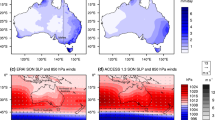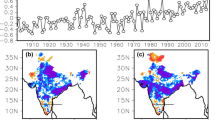Abstract
Severe flooding occurred in southern and northern China during the summer of 2016 when the 2015 super El Niño decayed to a normal condition. However, the mean precipitation during summer (June–July-August) 2016 does not show significant anomalies, suggesting that—over East Asia (EA)—seasonal mean anomalies have limited value in representing hydrological hazards. Scrutinizing season-evolving precipitation anomalies associated with 16 El Niño episodes during 1957–2016 reveals that, over EA, the spatiotemporal patterns among the four categories of El Niño events are quite variable, due to a large range of variability in the intensity and evolution of El Niño events and remarkable subseasonal migration of the rainfall anomalies. The only robust seasonal signal is the dry anomalies over central North China during the El Niño developing summer. Distinguishing strong and weak El Niño impacts is important. Only strong El Niño events can persistently enhance EA subtropical frontal precipitation from the peak season of El Niño to the ensuing summer, by stimulating intense interaction between the anomalous western Pacific anticyclone (WPAC) and underlying dipolar sea surface temperature anomalies in the Indo-Pacific warm pool, thereby maintaining the WPAC and leading to a prolonged El Niño impact on EA. A weak El Niño may also enhance the post-El Niño summer rainfall over EA, but through a different physical process: the WPAC re-emerges as a forced response to the rapid cooling in the eastern Pacific. The results suggest that the skillful prediction of rainfall over continental EA requires the accurate prediction of not only the strength and evolution of El Niño, but also the subseasonal migration of EA rainfall anomalies.
摘要
2016年夏季, 当2015 超强厄尔尼诺事件减弱到正常状态时, 中国南北方均发生了严重的洪涝灾害. 然而, 2016年夏季(六-八月)平均降水并没有呈现明显异常.这表明东亚夏季平均降水对于洪涝灾害的表征具有局限性.通过进一步分析最近60年间16次厄尔尼诺事件, 我们发现四种强度不同类型的厄尔尼诺事件引起的东亚降水异常的空间分布与季节演变相差甚大, 导致共同信号不显著, 给预报带来困难. 这是由于厄尔尼诺的强度和演变过程差异显著, 加之东亚夏季降水异常所独具的季节内北进使得夏季平均降水量失去代表性.唯一共同显著的信号表现在厄尔尼诺发展阶段的夏季中国北方中部地区的降水偏少. 在厄尔尼诺衰退的夏季, 区分强弱厄尔尼诺事件对于东亚降水的影响非常重要. 只有强厄尔尼诺事件能激发异常西太反气旋, 它通过与印度-西太暖池异常海温的相互作用得以维持, 增强自厄尔尼诺冬季至次年夏季东亚副热带锋区降水.弱厄尔尼诺事件也会加强东亚次年夏季降水, 但其物理过程不同, 那是由于东太平洋迅速降温而导致西太异常反气旋重新生成.结果表明, 准确的东亚夏季陆地降水预报要求动力模式不仅能对厄尔尼诺强度和演变做出准确预报, 还需要模式有能力预报出东亚异常雨带的季节内北进.
Similar content being viewed by others
References
Adler, R. F., and Coauthors, 2003: The version-2 global precipitation climatology project (GPCP) monthly precipitation analysis (1979-Present). Journal of Hydrometeorology, 4, 1147–1167, doi: 10.1175/1525-7541(2003)004<1147:TVGPCP>2.0.CO;2.
Chang, C.-P., Y. S. Zhang, and T. Li, 2000: Interannual and interdecadal variations of the east Asian summer monsoon and tropical Pacific SSTs. Part I: Roles of the Subtropical Ridge. J. Climate, 13, 4310–4325, doi: 10.1175/1520-0442(2000) 013<4310:IAIVOT>2.0.CO;2.
Chowdary, J., S.-P. Xie, J.-Y. Lee, Y. Kosaka, and B. Wang, 2010: Predictability of summer northwest Pacific climate in 11 coupled model hindcasts: Local and remote forcing. J. Geophys. Res., 115, D22121, doi: 10.1029/2010JD014595.
Ding, Q. H., and B. Wang, 2005: Circumglobal teleconnection in the northern hemisphere summer. J. Climate, 18, 3483–3505, doi: 10.1175/JCLI3473.1.
Ding, Q. H., B. Wang, J. M. Wallace, and G. Branstator, 2011: Tropical-extratropical teleconnections in boreal summer: Observed interannual variability. J. Climate, 24, 1878–1896, doi: 10.1175/2011JCLI3621.1.
Du, Y., S.-P. Xie, G. Huang, and K. M. Hu, 2009: Role of airsea interaction in the long persistence of EL Niño-induced north Indian OceanWarming. J. Climate, 22, 2023–2038, doi: 10.1175/2008JCLI2590.1.
Enomoto, T., B. J. Hoskins, and Y. Matsuda, 2003: The formation mechanism of the Bonin high in August. Quart. J. Roy. Meteor. Soc., 129, 157–178, doi: 10.1256/qj.01.211
Fu, C., and K. R. Li, 1978: The effects of tropical ocean on the western Pacific subtropical high. Oceanic Selections, No. 2, Ocean Press, 16–21.
Guo, Q. Y., 1987: The east Asia monsoon and the Southern Oscillation, 1871–1980. The Climate of China and Global Climate, D.-Z. Ye et al., Eds., Spinger-Verlag, 249–255.
Huang, B. Y., and Coauthors, 2016: Further exploring and quantifying uncertainties for extended reconstructed sea surface temperature (ERSST) version 4 (v4). J. Climate, 29, 3119–3142, doi: 10.1175/JCLI-D-15-0430.1.
Kalnay, E., and Coauthors, 1996: The NCEP/NCAR 40-year reanalysis project. Bull. Amer. Meteor. Soc., 77, 437–471, doi: 10.1175/1520-0477(1996)077<0437:TNYRP>2.0.CO;2.
Lau, N.-C., and M. J. Nath, 2000: Impact of ENSO on the variability of the Asian-Australian monsoons as simulated in GCM experiments. J. Climate, 13, 4287–4309, doi: 10.1175/1520-0442(2000)013<4287:IOEOTV>2.0.CO;2.
Lau, N.-C., and M. J. Nath, 2003: Atmosphere-ocean variations in the Indo-Pacific sector during ENSO episodes. J. Climate, 16, 3–20, doi: 10.1175/1520-0442(2003)016<0003:AOVITI>2.0.CO;2.
Lau, N.-C., and B. Wang, 2006: Interactions between the Asian monsoon and the El Niño/Southern Oscillation. The Asian Monsoon, B. Wang, Ed., Springer, Berlin Heidelberg, 479–512, doi: 10.1007/3-540-37722-0 12.
Lau, N.-C., M. J. Nath, and H. L. Wang, 2004: Simulations by a GFDL-GCM of ENSO related variability of the coupled atmosphere-ocean system in the East Asia monsoon region. East Asian Monsoon, C. P. Chang, Ed., World Scientific, 271–300, doi: 10.1142/9789812701411_0007.
Lau, N.-C., A. Leetmaa, M. J. Nath, and H.-L. Wang, 2005: Influences of ENSO-induced Indo-Western Pacific SST anomalies on extratropical atmospheric variability during the Boreal summer. J. Climate, 18, 2922–2942, doi: 10.1175/JCLI3445. 1.
Li, T., B. Wang, C.-P. Chang, and Y. S. Zhang, 2003: A theory for the Indian Ocean dipole-zonal mode. J. Atmos. Sci., 60, 2119–2135, doi: 10.1175/1520-0469(2003)060<2119:ATFTIO>2.0.CO;2.
Mason, S. J., and L. Goddard, 2001: Probabilistic precipitation anomalies associated with ENSO. Bull. Amer. Meteor. Soc., 82, 619–638, doi: 10.1175/1520-0477(2001)082<0619: PPAAWE>2.3.CO;2.
Meehl, G. A., 1987: The annual cycle and interannual variability in the Tropical Pacific and Indian Ocean regions. Mon. Wea. Rev., 115, 27–50, doi: 10.1175/1520-0493(1987)115<0027: TACAIV>2.0.CO;2.
Rayner, N. A., D. E. Parker, E. B. Horton, C. K. Folland, L. V. Alexander, D. P. Rowell, E. C. Kent, and A. Kaplan, 2003: Global analyses of sea surface temperature, sea ice, and night marine air temperature since the late nineteenth century. J. Geophys. Res., 108, 4407, doi: 10.1029/2002JD002670.
Ropelewski, C. F., and M. S. Halpert, 1987: Global and regional scale precipitation patterns associated with the El Niño/southern oscillation. Mon. Wea. Rev., 115, 1606–1626, doi: 10.1175/1520-0493(1987)115<1606:GARSPP>2.0.CO; 2.
Saji, N. H., B. N. Goswami, P. N. Vinayachandran, and T. Yamagata, 1999: A dipole mode in the tropical Indian Ocean. Nature, 401, 360–363.
Schneider, U., A. Becker, P. Finger, A. Meyer-Christoffer, M. Ziese, and B. Rudolf, 2014: GPCC’s new land surface precipitation climatology based on quality-controlled in situ data and its role in quantifying the global water cycle. Theor. Appl. Climatol., 115, 15–40, doi: 10.1007/s00704-013-0860-x.
Wang, B., 1995: Interdecadal changes in El Niño onset in the last four decades. J. Climate, 8, 267–285, doi: 10.1175/1520-0442(1995)008<0267:ICIENO>2.0.CO;2.
Wang, B., and Q. Zhang, 2002: Pacific-East Asian teleconnection. Part II: How the Philippine Sea anomalous anticyclone is established during El Niño development. J. Climate, 15, 3252–3265, doi: 10.1175/1520-0442(2002)015<3252:PEATPI>2.0.CO;2.
Wang, B., R. G. Wu, and X. H. Fu, 2000: Pacific-east Asian teleconnection: How does ENSO affect east Asian climate? J. Climate, 13, 1517–1536, doi: 10.1175/1520-0442(2000)013 <1517:PEATHD>2.0.CO;2.
Wang, B., R. G. Wu, and T. Li, 2003: Atmosphere-warm ocean interaction and its impacts on Asian-Australian monsoon variation. J. Climate, 16, 1195–1211, doi: 10.1175/1520-0442 (2003)16<1195:AOIAII>2.0.CO;2.
Wang, B., I.-S. Kang, and J.-Y. Lee, 2004: Ensemble simulations of Asian-Australian monsoon variability by 11 AGCMs. J. Climate, 17, 803–818, doi: 10.1175/1520-0442(2004)017 <0803:ESOAMV>2.0.CO;2.
Wang, B., Q. H. Ding, X. H. Fu, I.-S. Kang, K. Jin, J. Shukla, and F. Doblas-Reyes, 2005: Fundamental challenge in simulation and prediction of summer monsoon rainfall. Geophys. Res. Lett., 32, L15711, doi: 10.1029/2005GL022734.
Wang, B., J. Liu, J. Yang, T. J. Zhou, and Z. W. Wu, 2009a: Distinct principal modes of early and late summer rainfall anomalies in East Asia. J. Climate, 22, 3864–3875, doi: 10.1175/2009JCLI2850.1.
Wang, B., and Coauthors, 2009b: Advance and prospectus of seasonal prediction: assessment of the APCC/CliPAS 14-model ensemble retrospective seasonal prediction (1980-2004). Climate Dyn., 33, 93–117, doi: 10.1007/s00382-008-0460-0.
Wang, B., B. Q. Xiang, and J.-Y. Lee, 2013: Subtropical high predictability establishes a promising way for monsoon and tropical storm predictions. Proceedings of the National Academy of Sciences of the United States of America, 110, 2718–2722, doi: 10.1073/pnas.1214626110.
Wang, S. W., and Z. C. Zhao, 1981: Droughts and floods in China, 1470–1979. Climate and History, T. N. L. Wigley et al., Eds., Cambridge University Press, 271–288.
Wang, W.-C., and K. R. Li, 1990: Precipitation fluctuation over semiarid region in Northern China and the relationship with El Niño/Southern Oscillation. J. Climate, 3, 769–783, doi: 10.1175/1520-0442(1990)003<0769:PFOSRI>2.0.CO;2.
Webster, P. J., A. M. Moore, J. P. Loschnigg, and R. R. Leben, 1999: Coupled ocean-atmosphere dynamics in the Indian Ocean during 1997–98. Nature, 401, 356–360, doi: 10.1038/43848.
Wu, B., T. J. Zhou, and T. Li, 2009: Seasonally evolving dominant interannual variability modes of East Asian Climate. J. Climate, 22, 2992–3005, doi: 10.1175/2008JCLI2710.1.
Wu, R. G., 2017: Relationship between Indian and East Asian summer rainfall variations. Adv. Atmos. Sci., 34, 4–15, doi: 10.1007/s00376-016-6216-6.
Wu, R. G., Z.-Z. Hu, and B. P. Kirtman, 2003: Evolution of ENSOrelated rainfall anomalies in East Asia. J. Climate, 16, 3742–3758, doi: 10.1175/1520-0442(2003)016<3742:EOERAI>2.0.CO;2.
Xiang, B. Q., B. Wang, W. D. Yu, and S. B. Xu, 2013: How can anomalous western North Pacific Subtropical High intensify in late summer? Geophys. Res. Lett., 40, 2349–2354, doi: 10.1002/grl.50431.
Xie, S.-P., K. M. Hu, J. Hafner, H. Tokinaga, Y. Du, G. Huang, and T. Sampe, 2009: Indian ocean capacitor effect on Indo-Western Pacific climate during the summer following El Niño. J. Climate, 22, 730–747, doi: 10.1175/2008 JCLI2544.1.
Xie, S.-P., Y. Kosaka, Y. Du, K. M. Hu, J. S. Chowdary, and G. Huang, 2016: Indo-Western Pacific Ocean capacitor and coherent climate anomalies in Post-ENSO summer: A review. Adv. Atmos. Sci., 33, 411–432, doi: 10.1007/s00376-015-5192-6.
Xing, W., B. Wang, and S.-Y. Yim, 2016: Peak-summer East Asian rainfall predictability and prediction part I: Southeast Asia. Climate Dyn., 47, 1–13, doi: 10.1007/s00382-014-2385-0.
Xing, W., B. Wang, S.-Y. Yim, and K.-J. Ha, 2017: Predictable patterns of the May-June rainfall anomaly over East Asia. J. Geophys. Res., 122, 2203–2217, doi: 10.1002/2016JD025856.
Yang, J. L., Q. Y. Liu, S.-P. Xie, Z. Y. Liu, and L. X. Wu, 2007: Impact of the Indian Ocean SST basin mode on the Asian summer monsoon. Geophys. Res. Lett., 34, L02708, doi: 10.1029/2006GL028571.
Yasunari, T., 1991: The monsoon year-a new concept of the climatic year in the tropics. Bull. Amer. Meteor. Soc., 72, 1331–1338, doi: 10.1175/1520-0477(1991)072<1331:TMYNCO> 2.0.CO;2.
Yim, S.-Y., B. Wang, and M. Kwon, 2014a: Interdecadal change of the controlling mechanisms for East Asian early summer rainfall variation around the mid-1990s. Climate Dyn., 42, 1325–1333, doi: 10.1007/s00382-013-1760-6.
Yim, S.-Y., B. Wang, and W. Xing, 2014b: Prediction of early summer rainfall over South China by a physical-empirical model. Climate Dyn., 43, 1883–1891, doi: 10.1007/s00382-013-2014-3.
Yim, S.-Y., B. Wang, and W. Xing, 2016: Peak-summer East Asian rainfall predictability and prediction part II: Extratropical East Asia. Climate Dyn., 47, 15–30, doi: 10.1007/s00382-015-2849-x.
Yuan, Y., and S. Yang, 2012: Impacts of different types of El Niño on the East Asian climate: Focus on ENSO cycles. J. Climate, 25, 7702–7722, doi: 10.1175/JCLI-D-11-00576.1.
Zhang, R. H., A. Sumi, and M. Kimoto, 1999: A diagnostic study of the impact of El Niño on the precipitation in China. Adv. Atmos. Sci., 16, 229–241, doi: 10.1007/BF02973084.
Acknowledgements
This study was supported by the National Natural Science Foundation of China (Grant No. 41420104002) and the National Research Foundation of Korea through a Global Research Laboratory grant of the Korean Ministry of Education, Science and Technology (Grant No. 2011-0021927) and the Atmosphere–Ocean Research Center (AORC). The AORC is partially funded by Nanjing University of Information Science and Technology (NUIST). This paper is NUIST-Earth System Modeling Center publication number 163, School of Ocean and Earth Science and Technology publication number 10027, and International Pacific Research Center publication number 1259.
Author information
Authors and Affiliations
Corresponding author
Rights and permissions
About this article
Cite this article
Wang, B., Li, J. & He, Q. Variable and robust East Asian monsoon rainfall response to El Niño over the past 60 years (1957–2016). Adv. Atmos. Sci. 34, 1235–1248 (2017). https://doi.org/10.1007/s00376-017-7016-3
Received:
Revised:
Accepted:
Published:
Issue Date:
DOI: https://doi.org/10.1007/s00376-017-7016-3
Keywords
- El Niño impact
- monsoon rainfall
- East Asian monsoon
- Asian monsoon
- precipitation variability
- monsoon–ocean interaction
- western Pacific subtropical high




